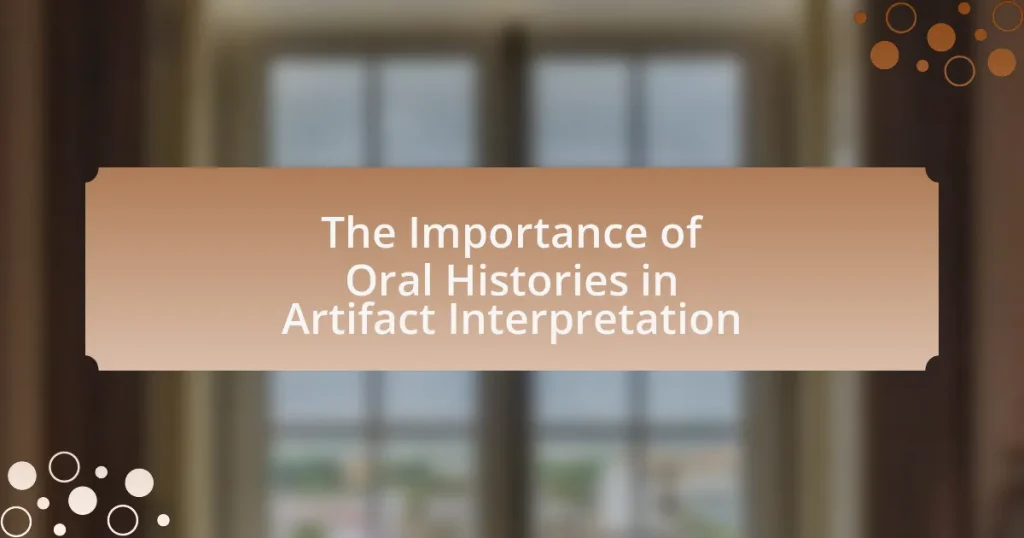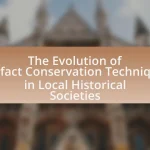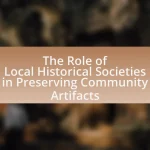The article focuses on the significance of oral histories in the interpretation of artifacts, emphasizing their role in providing contextual narratives that enhance understanding of cultural and historical significance. It discusses how oral histories reveal social practices, beliefs, and values associated with artifacts, filling gaps in the historical record that written documentation may overlook. The article also outlines methodologies for collecting oral histories, the challenges faced in this process, and the ethical considerations involved. Additionally, it highlights case studies that illustrate the impact of oral histories on artifact interpretation and offers best practices for integrating these narratives into museum exhibits and educational programs.
What is the significance of oral histories in artifact interpretation?
Oral histories are significant in artifact interpretation as they provide contextual narratives that enhance understanding of the artifacts’ cultural and historical significance. These narratives often include personal experiences, traditions, and meanings associated with the artifacts, which are not always evident through physical examination alone. For instance, oral histories can reveal the social practices, beliefs, and values of a community, thereby enriching the interpretation of artifacts found in archaeological sites. This approach is supported by studies such as “Oral History and the Archaeology of the Contemporary World” by Paul A. Shackel, which emphasizes the importance of integrating oral traditions with material culture to create a more comprehensive understanding of the past.
How do oral histories enhance our understanding of artifacts?
Oral histories enhance our understanding of artifacts by providing contextual narratives that explain their significance and use within specific cultures. These narratives often reveal the social, cultural, and historical backgrounds associated with the artifacts, which are not always evident through physical examination alone. For instance, oral histories can illuminate the intended purpose of an artifact, its role in rituals, or its connection to community identity, thereby enriching the interpretation of the artifact. This is supported by studies such as “The Role of Oral History in Understanding Material Culture” by Barbara Allen, which emphasizes that oral traditions can fill gaps in the historical record, offering insights that written documentation may overlook.
What types of information can oral histories provide about artifacts?
Oral histories can provide contextual information, personal narratives, and cultural significance about artifacts. These narratives often include details about the artifact’s origin, usage, and the stories surrounding its creation or ownership, which may not be documented in written records. For example, oral histories can reveal how an artifact was used in daily life, its role in rituals, or its significance within a community, thereby enriching the understanding of the artifact’s historical and cultural context. This information is crucial for interpreting artifacts accurately, as it adds depth and perspective that complements physical evidence.
How do personal narratives shape the context of artifacts?
Personal narratives shape the context of artifacts by providing subjective interpretations that enhance understanding of their significance. These narratives offer insights into the cultural, emotional, and historical dimensions of artifacts, allowing for a richer interpretation beyond mere physical characteristics. For instance, oral histories shared by individuals connected to an artifact can reveal its role in community identity or personal experiences, thus contextualizing its value within a specific social framework. Research indicates that artifacts interpreted through personal narratives can lead to deeper engagement and appreciation, as evidenced by studies showing that visitors to museums who encounter personal stories related to artifacts report a more meaningful experience.
Why are oral histories considered a vital source of information?
Oral histories are considered a vital source of information because they provide firsthand accounts and personal narratives that capture the lived experiences of individuals and communities. These narratives often fill gaps in historical records, offering insights into cultural practices, social dynamics, and events that may not be documented elsewhere. For instance, oral histories can reveal perspectives on significant historical events, such as the Civil Rights Movement, that are often overlooked in traditional historical texts. By preserving these unique voices, oral histories contribute to a more comprehensive understanding of history and culture, making them essential for artifact interpretation and the study of human experiences.
What role do oral histories play in preserving cultural heritage?
Oral histories play a crucial role in preserving cultural heritage by capturing and transmitting the lived experiences, traditions, and values of communities. These narratives provide a rich, personal context that written records often lack, allowing for a deeper understanding of cultural practices and historical events. For instance, oral histories have been instrumental in documenting Indigenous cultures, where storytelling serves as a primary means of knowledge transfer, ensuring that traditions are maintained across generations. Research indicates that oral histories can enhance the representation of marginalized voices, thereby enriching the overall narrative of cultural heritage and fostering a sense of identity and continuity within communities.
How do oral histories contribute to the authenticity of artifacts?
Oral histories enhance the authenticity of artifacts by providing contextual narratives that validate their origins and significance. These narratives often include firsthand accounts from individuals connected to the artifacts, which can corroborate historical facts and details about their use, creation, and cultural relevance. For instance, oral traditions can reveal the intended purpose of an artifact, its role in rituals, or its connection to specific events, thereby enriching the understanding of the artifact’s historical context. This corroboration is crucial, as it helps to bridge gaps in the written record, particularly for cultures with limited documentation.
What methodologies are used in collecting oral histories for artifact interpretation?
Qualitative methodologies are primarily used in collecting oral histories for artifact interpretation. These methodologies include in-depth interviews, focus groups, and narrative analysis, which allow for the gathering of personal experiences and contextual information related to artifacts. In-depth interviews facilitate a detailed exploration of individual perspectives, while focus groups encourage discussion among multiple participants, revealing collective insights. Narrative analysis helps in understanding the stories behind artifacts, providing a richer context for interpretation. These methods are validated by their widespread application in historical research, demonstrating their effectiveness in capturing the nuances of personal and cultural histories.
How is the process of gathering oral histories conducted?
The process of gathering oral histories is conducted through structured interviews that capture personal narratives and experiences. Interviewers typically prepare by researching the subject’s background and formulating open-ended questions to encourage detailed responses. During the interview, the interviewer creates a comfortable environment, actively listens, and records the conversation, often using audio or video equipment to ensure accuracy. This method allows for the collection of rich, contextual information that can enhance understanding of artifacts and their significance, as evidenced by projects like the Library of Congress’s American Folklife Center, which has documented diverse cultural histories through oral interviews.
What techniques are effective in interviewing individuals about artifacts?
Effective techniques for interviewing individuals about artifacts include open-ended questions, active listening, and contextual prompts. Open-ended questions encourage detailed responses, allowing interviewees to share their personal experiences and insights related to the artifacts. Active listening ensures that the interviewer fully engages with the interviewee, fostering a comfortable environment that promotes deeper conversation. Contextual prompts, such as asking about the significance of specific artifacts or their history, help guide the discussion and elicit richer narratives. These techniques are supported by research indicating that qualitative interviews yield more comprehensive data when participants feel encouraged to express their thoughts freely and when interviewers demonstrate genuine interest in their stories.
How can researchers ensure the reliability of oral histories?
Researchers can ensure the reliability of oral histories by employing systematic methods for data collection and verification. This includes cross-referencing oral accounts with existing historical records, utilizing multiple sources to corroborate information, and conducting interviews in a consistent manner to minimize bias. Additionally, researchers can enhance reliability by documenting the context of each oral history, such as the interviewee’s background and the circumstances under which the account was given. Studies have shown that triangulating data from various sources significantly increases the credibility of oral histories, as evidenced by the work of historians like Paul Thompson, who emphasized the importance of contextualizing oral narratives within broader historical frameworks.
What challenges are faced in the collection of oral histories?
The collection of oral histories faces several challenges, including issues of memory reliability, participant willingness, and cultural sensitivity. Memory reliability can be compromised as individuals may forget details or alter their narratives over time, leading to inaccuracies. Participant willingness is often affected by the emotional weight of the stories being shared, which can deter individuals from recounting painful experiences. Additionally, cultural sensitivity is crucial, as some communities may have specific protocols regarding storytelling and sharing personal histories, which must be respected to ensure ethical collection practices. These challenges necessitate careful planning and consideration by researchers to obtain accurate and respectful oral histories.
How do biases affect the interpretation of oral histories?
Biases significantly affect the interpretation of oral histories by shaping the narratives that individuals choose to share and how they are perceived. Personal, cultural, and societal biases can lead to selective memory, where certain events are emphasized or downplayed based on the storyteller’s perspective. For instance, a study by Paul Thompson in “The Voice of the Past” highlights that oral histories often reflect the dominant cultural narratives, which can marginalize alternative viewpoints. This selective representation can distort historical understanding, as the experiences of underrepresented groups may be overlooked or misrepresented, leading to an incomplete or skewed interpretation of the past.
What ethical considerations must be taken into account when collecting oral histories?
When collecting oral histories, ethical considerations include informed consent, confidentiality, and the potential impact on the interviewee. Informed consent ensures that participants understand the purpose of the interview and how their narratives will be used, which is crucial for respecting their autonomy. Confidentiality protects the identity of the interviewees, especially when discussing sensitive topics, thereby fostering trust and encouraging openness. Additionally, researchers must consider the potential emotional and social repercussions of sharing personal stories, as these narratives can affect the interviewee’s relationships and community standing. These ethical principles are essential for conducting responsible and respectful oral history projects.
How do oral histories influence the interpretation of specific artifacts?
Oral histories significantly influence the interpretation of specific artifacts by providing contextual narratives that enrich understanding. These narratives often reveal the cultural, social, and historical significance of artifacts, which may not be evident through physical examination alone. For instance, oral histories can illuminate the intended use, symbolic meanings, and personal stories associated with an artifact, thereby offering insights into the lives of the people who created or utilized them. Research has shown that integrating oral histories with archaeological findings leads to a more nuanced interpretation, as evidenced by studies that highlight how indigenous oral traditions have clarified the purpose of tools and ceremonial objects in various cultures.
What case studies illustrate the impact of oral histories on artifact interpretation?
Case studies such as the “Smithsonian’s National Museum of the American Indian” and the “Yale Peabody Museum of Natural History” illustrate the impact of oral histories on artifact interpretation. In the Smithsonian case, oral histories from Native American communities provided context that transformed the understanding of artifacts, revealing cultural significance and traditional uses that were previously overlooked. Similarly, the Yale Peabody Museum incorporated oral narratives from Indigenous peoples, which enriched the interpretation of their collections and highlighted the living traditions associated with the artifacts. These examples demonstrate that oral histories can significantly enhance the contextual understanding of artifacts, leading to more accurate and respectful representations of cultural heritage.
How did oral histories change the understanding of a particular artifact?
Oral histories significantly changed the understanding of the artifact by providing context and narratives that were previously undocumented. For instance, the oral traditions surrounding the Native American artifacts revealed cultural practices, meanings, and historical events that were not captured in written records. This additional layer of information allowed researchers to reinterpret the artifact’s significance, linking it to specific community practices and beliefs, thereby enriching the overall understanding of its role in society.
What lessons can be learned from successful oral history projects?
Successful oral history projects demonstrate the importance of community engagement and the value of diverse perspectives. These projects often highlight that involving local communities in the storytelling process enriches the narratives and fosters a sense of ownership. For instance, the “StoryCorps” initiative has shown that capturing personal stories from various demographics leads to a more comprehensive understanding of historical events, as evidenced by the thousands of recorded interviews that reflect a wide range of experiences and viewpoints. Additionally, successful projects emphasize the need for careful planning and ethical considerations, ensuring that participants feel respected and their stories are accurately represented. This approach not only preserves history but also strengthens community bonds, as seen in projects like the “Veterans History Project,” which honors the contributions of veterans while providing them a platform to share their experiences.
What best practices should be followed when integrating oral histories into artifact interpretation?
Best practices for integrating oral histories into artifact interpretation include ensuring the accuracy and context of the oral narratives, actively involving community members in the process, and using a multidisciplinary approach. Accurate oral histories provide personal insights that enhance the understanding of artifacts, while community involvement fosters trust and authenticity. A multidisciplinary approach, incorporating perspectives from history, anthropology, and cultural studies, enriches the interpretation process. Research indicates that when oral histories are combined with artifacts, they create a more comprehensive narrative, as seen in projects like the Smithsonian’s National Museum of African American History and Culture, which effectively integrates personal stories with historical objects to deepen visitor engagement and understanding.
How can museums and institutions effectively utilize oral histories?
Museums and institutions can effectively utilize oral histories by integrating them into exhibitions and educational programs to provide personal narratives that enhance the understanding of artifacts. This approach allows visitors to connect emotionally with historical events and cultural contexts, making the experience more relatable and impactful. For instance, the Smithsonian Institution has successfully incorporated oral histories into its exhibits, allowing visitors to hear firsthand accounts that complement the displayed artifacts, thereby enriching the interpretive experience.
What strategies can enhance the collaboration between historians and community members?
Enhancing collaboration between historians and community members can be achieved through strategies such as inclusive workshops, community-led projects, and the integration of oral histories. Inclusive workshops allow historians to engage directly with community members, fostering a two-way exchange of knowledge and perspectives. Community-led projects empower local individuals to take ownership of their history, ensuring that the narratives reflect their experiences and values. The integration of oral histories into historical research provides a richer, more nuanced understanding of artifacts, as it captures personal stories and cultural contexts that traditional methods may overlook. These strategies not only strengthen the relationship between historians and communities but also enrich the historical narrative by incorporating diverse voices and experiences.















